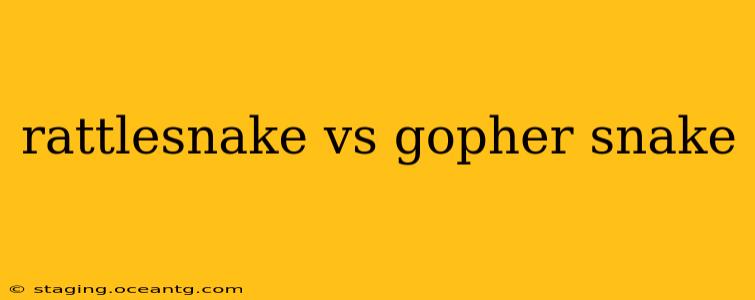Identifying snakes can be crucial for safety, especially when dealing with venomous species like rattlesnakes. Often, harmless snakes are mistaken for venomous ones, leading to unnecessary fear and even harm to the snake. This guide will help you differentiate between rattlesnakes and gopher snakes, two common North American species that frequently cause confusion.
What are the Key Differences Between Rattlesnakes and Gopher Snakes?
The most significant difference, and the easiest to spot, is the rattle. Rattlesnakes possess a distinctive rattle at the end of their tail, a feature completely absent in gopher snakes. However, young rattlesnakes may have a button rattle that is difficult to see or hear, so relying solely on this feature isn't always reliable.
Beyond the rattle, several other characteristics distinguish these snakes:
Head Shape
- Rattlesnakes: Have triangular-shaped heads, broader than their necks. This is due to the presence of venom glands.
- Gopher Snakes: Possess heads that are more rounded or slightly oval and smoothly tapered into their necks.
Heat-Sensing Pits
- Rattlesnakes: Most rattlesnakes have heat-sensing pits located between their eyes and nostrils. These pits help them detect warm-blooded prey.
- Gopher Snakes: Lack heat-sensing pits.
Body Pattern and Coloration
While coloration can vary within each species depending on location and subspecies, some general trends exist:
- Rattlesnakes: Often exhibit bold patterns, such as diamonds, bands, or blotches, against a background color ranging from tan to brown or grey.
- Gopher Snakes: Typically have a more subdued coloration, often mimicking the color of the surrounding environment. They might have darker blotches or stripes, but these are generally less pronounced than those found on rattlesnakes.
Behavior
- Rattlesnake: Will often rattle their tail as a warning before striking. They are generally less likely to flee from a confrontation unless threatened or cornered.
- Gopher Snake: Are typically non-aggressive and will usually try to escape confrontation. If cornered, they may bluff strike or vibrate their tails in the leaf litter to create a rattling sound which is often mistaken for a rattlesnake's warning.
How Can I Tell the Difference if I Only See a Part of the Snake?
If you only catch a glimpse of a snake, positive identification can be difficult. Focusing on the head shape can be helpful, even from a distance. A triangular head strongly suggests a rattlesnake. However, remember that other venomous snakes exist, so erring on the side of caution is always best if you are unsure.
What Should I Do if I Encounter a Snake I Suspect is a Rattlesnake?
- Give it space: Maintain a safe distance and avoid approaching or trying to handle the snake.
- Keep pets away: Keep your pets away from the snake.
- Alert others: If you're in a public area, inform others nearby.
- Leave the area: Slowly and calmly back away from the snake, avoiding sudden movements that might startle it.
Are Gopher Snakes Poisonous or Venomous?
Gopher snakes are non-venomous. While they may bite if handled roughly or threatened, their bite is not dangerous to humans, posing only a minor injury.
What do Rattlesnakes and Gopher Snakes Eat?
Both rattlesnakes and gopher snakes are carnivorous, though their preferred prey differs slightly:
- Rattlesnakes: Primarily feed on rodents, birds, and other small mammals.
- Gopher Snakes: Often prey on rodents, lizards, and other snakes, including venomous snakes! This makes them a valuable part of the ecosystem.
Are there any other snakes that could be mistaken for a rattlesnake?
Yes, several other snake species, especially in certain regions, might share similar characteristics with rattlesnakes and cause confusion. Always utilize multiple identification methods and consult with local herpetologists or wildlife experts if you have any doubts.
This guide provides general information. Regional variations in coloration and patterns exist for both rattlesnakes and gopher snakes. Always prioritize safety and avoid handling snakes unless you are a trained professional.
